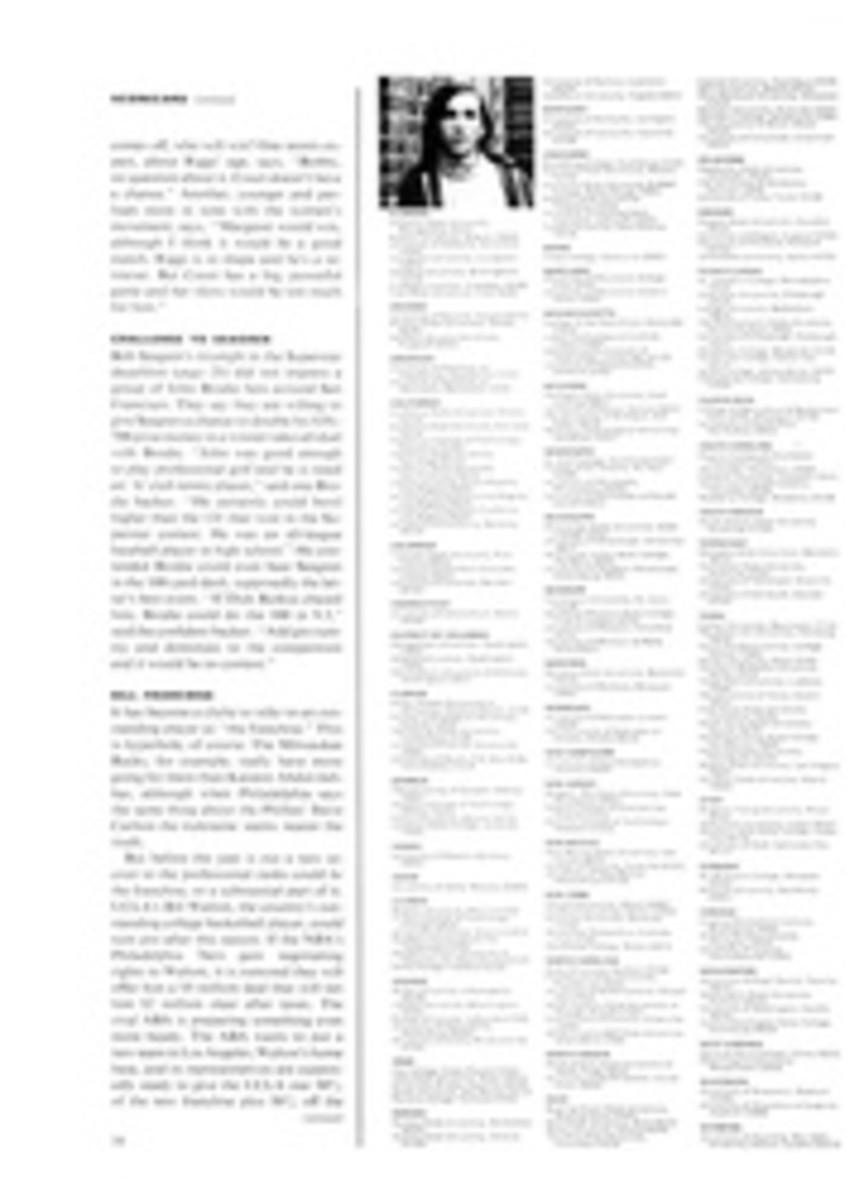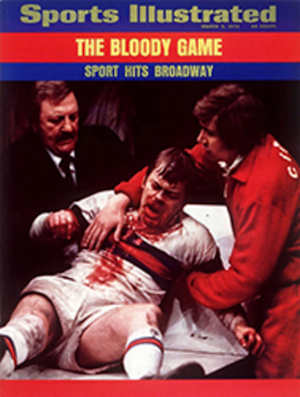
POOR PERRY PASSED THE BUCK
Kentucky Derby favorite Secretariat will be syndicated for $6 million. Which makes it all the more ironic that one of the top racehorses in the land—a gelding named Crusading—was bought only a year ago for $1.
Last Saturday in the $83,150 San Antonio Stakes the 5-year-old bay, now owned by a veterinarian, James Temple, sought his sixth straight win and his ninth in 11 lifetime starts. Though it was six weeks since his last race and he had trained too lightly (he dislikes taking the slightest exercise in mud and Santa Anita has been a sea of slop recently), Crusading went off the 8-to-5 favorite of 40,000 fans. He charged alongside Kennedy Road as the field turned for home and dueled through the stretch, only to lose by a nose in a flailing finish. It is no longer just sentimentalism to rank Crusading among the favorites for the upcoming Santa Anita Handicap. He belongs with the best.
In 1968 at Kentucky's vaunted Claiborne Farm, the newly foaled Crusading seemed to have excellent prospects. He was a son of Round Table and his dam was a stakes-winning daughter of Bold Ruler. He was also remarkably handsome. But the following year the colt turned into a rogue. "He became mean," declares Seth Hancock, whose late father owned the stud. "He was so rough to handle that two grooms quit."
That fall, however, when Trainer Jim Maloney visited Claiborne to choose a number of yearlings to race for Owner William Haggin Perry, the colt seemed a model of decorum. "I wasn't aware of his meanness," Maloney says. "In fact, Crusading was my first choice among all the horses. He was a good-looker and his dam, Terentia, had ability despite being unsound. She won $125,000 for our stable. I thought Crusading would be a good one."
Almost immediately things went bad. Like his dam, Crusading became perpetually sore. The lameness would shift mysteriously from one leg to another, and on more than one occasion the steadily growing colt stumbled so badly he fell down. The horse could not be trained—it was too risky for an exercise rider to gallop him. So he went un-raced at two. The next year he showed no sign of improving and, because he had become overly fat, was gelded.
When Jim Maloney shipped his stable East from Santa Anita in April 1971, Crusading was left behind. Dr. Temple, the stable's veterinarian, agreed to look after the horse. He took the gelding into the foothills of the San Gabriel Mountains where he owns a six-acre ranch in Bradbury Estates. The vet turned Crusading out under the avocado trees with a motley group of ponies, mares and pensioners and set about solving his problems. "The infirmities were puzzling," Temple explains. "Not only would the soreness move from leg to leg, it would move from one part of a leg to another part. Operating on a sesamoid didn't solve anything. One day it would be a knee, the next time a foot. Tests showed he was having metabolic trouble. His calcium and phosphorous levels were way out of position, so I put him on high dosages of vitamins, proteins and amino acids. He received shots daily, and pretty soon he showed so much improvement that I began riding him around the ranch."
In July the horse was sent back to the track but he went wrong again. Thoroughly discouraged, Owner Perry suggested that Temple might be able to use Crusading as a saddle horse. The vet took the bay home and soon after had him exercising daily in a 65-foot ring. In December when Perry's stable arrived in California for the Santa Anita meeting, Temple returned his "saddle horse" to Trainer Maloney, apparently cured. But when Crusading flopped once more, this time just after New Year's, Perry was determined to get rid of his problem horse. And no one could blame him. Crusading was now four and still unraced.
On February 7, 1972, as Perry was standing in front of his barn, he heard a loud thump: Crusading had fallen in his stall walking from the hayrack to the water bucket. "That did it," Perry recalls. "I turned to Jim Temple and said, 'You can have him for a dollar. That will make the sale legal.' Jim said he'd buy. The check went through my bookkeeper's office in Middleburg, Va., just like any other business dealing."
Continuing the series of shots, Temple turned over his purchase to a young horseman named Tommy Pratt. "I gave the horse nothing but slow works for a long, long time," says Pratt. "When I got him he was 100 pounds overweight. I thought if we could run him in a $10,000 claiming race everyone could make a little profit. But one day I put Jockey Fernando Toro on him and said, 'Let's see what he'll do.' He went five-eighths of a mile in 58[3/5] [a clocking that would equal or better the record at some tracks]. I knew then that we had ourselves a racehorse." The bay made his first start at Hollywood Park in April 1972, won by four lengths, and has been off to the races since.
Now fully recovered from his severely anemic condition, Crusading is down to two vitamin shots each week and, with these, his metabolism level has remained fairly constant. Going into the San Antonio he had earned $92,325. He had won the Palos Verdes Handicap at six furlongs and the San Carlos Handicap at seven furlongs, although the latter victory was achieved on the disqualification of Kennedy Road, who finished a nose in front in that race, too.
"Crusading took a lot of schooling," says Pratt. "He was so rough in the paddock and at the gate. Track officials gave me permission to work him between races, and this helped. As for the rest of his training, I'm in the position now to say it's easy to train a good horse. From the start, I taught Crusading how to rate. I don't want any horse of mine busting off in front and running himself into the ground. If you don't know him, though, you might still think he's lame at times. He has a lame horse's habit of slinging his head up and down. His first two losses were our fault, not his. Once I ran him in flat shoes on the grass and that was a mistake. The other time the stable pony acted up and unsettled him on the way to the post."
Bill Perry seems to have few regrets about the bargain sale. "I have no sour feelings," he says. "I still own the mare, and I have a full brother to Crusading in training in Ireland. I thought it would be nice to give Dr. Temple a horse to hack around his ranch, but I'm delighted he's winning stakes with him instead."
Fortunately, the Perry stable, traditionally one of the strongest at Santa Anita, does not have a ranking handicapper in racing at the moment, thereby eliminating any chance of embarrassment. Crusading faced a field of six in the San Antonio, including in addition to his nemesis, Kennedy Road, the San Pasqual winner, Single Agent.
The gelding drew the outside post position, which Pratt considered unfortunate. Crusading would need a good start in the mile-and-an-eighth race, and the trouble is that for all his years, Temple's horse is still a relatively green performer. As Pratt feared, Crusading broke slowly. He ran wide into the first turn and was carried out still farther by other horses. The field was midway down the backstretch before Toro was able to ease the gelding close to the rail. In the far turn Crusading moved smartly toward the leaders, surging into second behind Kennedy Road. Roaring off the turn, the two horses moved into the stretch side by side. Track Announcer Terry Gilligan called Crusading in front near the eighth pole (but the official chart of the race never shows him on top). As they passed under the wire, it seemed not the width of a whip separated the two. But Kennedy Road eventually was declared the winner. "It was close close," said Pratt. "Being forced wide on the first turn took a little out of Crusading that he needed in the stretch." Toro declared that all those lost workouts also had hurt the horse.
If the skies are clear and Crusading is at his fittest on March 10, he will be a contender in the big handicap, which will draw the nation's best older horses—Cougar II, Bicker, Royal Owl and Quack, as well as Kennedy Road. In any case, the long-range forecast for Crusading is excellent. He has been so lightly raced that he should have many good seasons ahead of him. He could compete for years, until he, uh, dropped. But Dr. Temple regards his bargain fondly. "We'll only race Crusading until he loses interest," the vet says. Which seems fair. The doctor already has gotten his money's worth.
TWO PHOTOS
Patience has paid off big for Trainer Pratt (left) and Owner Temple as Crusading (in blinkers at the San Antonio finish) battles with the best.

